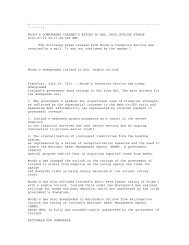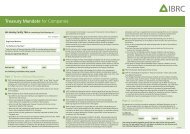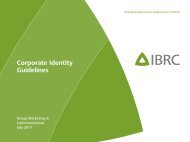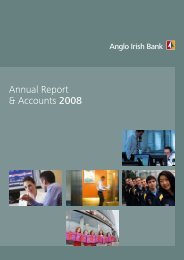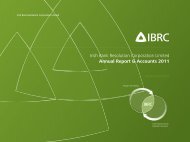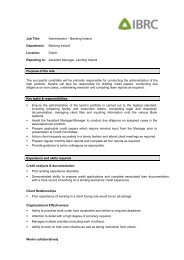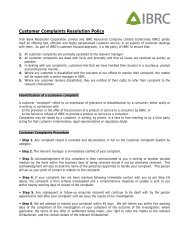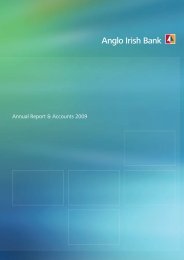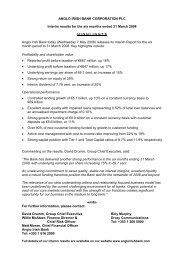IBRC annual report for 2011 - Irish Bank Resolution Corporation ...
IBRC annual report for 2011 - Irish Bank Resolution Corporation ...
IBRC annual report for 2011 - Irish Bank Resolution Corporation ...
Create successful ePaper yourself
Turn your PDF publications into a flip-book with our unique Google optimized e-Paper software.
<strong>Irish</strong> <strong>Bank</strong> <strong>Resolution</strong> <strong>Corporation</strong> LimitedAnnual Report & Accounts <strong>2011</strong>A liability upon initial recognition may be designated at fair value through profit or loss when:a) it eliminates or significantly reduces a measurement or recognition inconsistency that would otherwise arise from measuringassets or liabilities or recognising the gains and losses on them on different bases; orb) a group of financial assets, financial liabilities or both is managed and its per<strong>for</strong>mance is evaluated on a fair value basis, inaccordance with a documented risk management or investment strategy; orc) a financial instrument contains one or more embedded derivatives that significantly modify the cash flows arising from theinstrument and would otherwise need to be accounted <strong>for</strong> separately.The principal categories of financial liabilities designated at fair value through profit or loss are (a) investment contracts issued by theGroup's assurance company: fair value designation significantly reduces the measurement inconsistency that would arise if theseliabilities were measured at amortised cost, and (b) structured liabilities issued by the Group: designation significantly reduces themeasurement inconsistency between these liabilities and the related derivatives carried at fair value.Net gains and losses on financial liabilities designated at fair value through profit or loss are recognised in net trading expense. Gains andlosses arising from changes in the fair value of derivatives that are managed in conjunction with financial liabilities designated at fairvalue through profit or loss are included in net trading expense.The classification of instruments as a financial liability or an equity instrument is dependent upon the substance of the contractualarrangement. Instruments which carry a contractual obligation to deliver cash or another financial asset to another entity are classified asfinancial liabilities.Preference shares and other subordinated capital instruments issued are classified as financial liabilities if coupon payments are notdiscretionary. Distributions on these instruments are recognised in profit or loss as interest expense using the effective interest ratemethod.1.12 Financial guaranteesA financial guarantee contract is a contract that requires the issuer to make specified payments to reimburse the holder <strong>for</strong> a loss itincurs because the guaranteed party fails to meet a contractual obligation or to make payment when due in accordance with the originalor modified terms of a debt instrument.Financial guarantees are given to banks, financial institutions and other bodies on behalf of customers to secure loans, overdrafts andother banking facilities and to other parties in connection with the per<strong>for</strong>mance of customers under obligations related to contracts,advance payments made by other parties, tenders, retentions and the payment of import duties and taxes.Financial guarantees are initially recognised in the financial statements at fair value on the date that the guarantee was given.Subsequent to initial recognition, the Group's liabilities under such guarantees are measured at the higher of the initial measurement,less amortisation calculated to recognise in the income statement the fee income earned over the period, and the best estimate of theexpenditure required to settle any financial obligation arising as a result of the guarantees at the end of the <strong>report</strong>ing period.Where the parent <strong>Bank</strong> enters into financial guarantee contracts to guarantee the indebtedness of other Group companies, the parent<strong>Bank</strong> considers these contracts to be insurance arrangements and accounts <strong>for</strong> them as such. The parent <strong>Bank</strong> treats these guaranteecontracts as contingent liabilities until such time as it becomes probable that it will be required to make a payment under theseguarantees.1.13 Impairment of financial assetsIt is Group policy to make provisions <strong>for</strong> impairment of financial assets to reflect the losses inherent in those assets at the end of the<strong>report</strong>ing period.The Group assesses at the end of each <strong>report</strong>ing period whether there is objective evidence that a financial asset or a portfolio offinancial assets is impaired. A financial asset or a portfolio of financial assets is impaired and impairment losses are incurred if, and onlyif, there is objective evidence of impairment as a result of one or more loss events that occurred after the initial recognition of the assetand that loss event (or events) has had an impact such that the estimated present value of future cash flows is less than the currentcarrying value of the financial asset, or portfolio of financial assets, and can be reliably measured.Objective evidence that a financial asset, or a portfolio of financial assets, is potentially impaired includes observable data that comes tothe attention of the Group about the following loss events:a) significant financial difficulty of the issuer or obligor;b) a breach of contract, such as a default or delinquency in interest or principal payments;c) the granting to the borrower of a concession, <strong>for</strong> economic or legal reasons relating to the borrower's financial difficulty, thatthe Group would not otherwise consider;d) it becoming probable that the borrower will enter bankruptcy or other financial reorganisation;e) the disappearance of an active market <strong>for</strong> that financial asset because of financial difficulties; orf) observable data indicating that there is a measurable decrease in the estimated future cash flows from a portfolio of financialassets since the initial recognition of those assets, although the decrease cannot yet be identified within the individualfinancial assets in the portfolio, including:- adverse changes in the payment status of borrowers in the portfolio; or- national or local economic conditions that correlate with defaults on the assets in the portfolio.47





